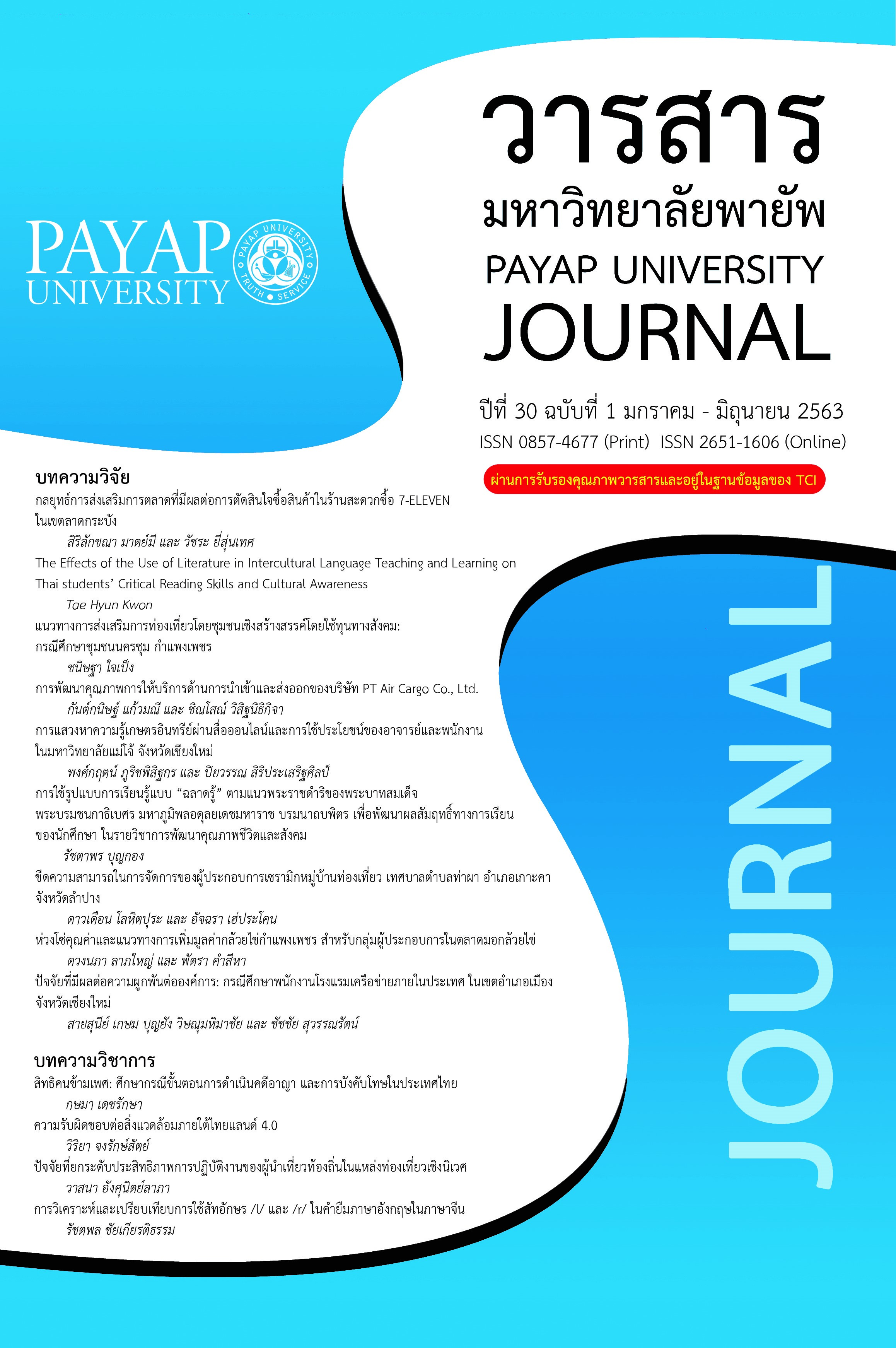The Effects of the Use of Literature in Intercultural Language Teaching and Learning on Thai students’ Critical Reading Skills and Cultural Awareness
Main Article Content
Abstract
Critical reading and cultural awareness are crucial for students for academic success and becoming global citizens. However, Thai students have a lack of critical abilities in academic performance and little understanding of other cultures. This research aimed to investigate the effects of the use of literature in Intercultural Language Teaching and Learning (ILTL) on Thai students’ critical reading skills and cultural awareness. Twenty Thai high school students studied for 30 hours with four cultural short-stories. The data was collected from critical reading quizzes, pre- and post-tests, journals, and analyzed by mean scores and paired sample test. The results showed that the use of literature in Intercultural Language Teaching and Learning helped to develop critical reading skills and cultural awareness. Through classroom activities such as comparison and group discussions with guided questions, students were able to identify and evaluate cultural products, practices, and perspectives, despite a lack of English skills. Through the recirculating teaching framework sequence of comprehending, comparing, evaluating, and collaborating, critical reading skills and cultural awareness can be taught and improved.
Article Details
References
Boa, E. A., Wattanatorn, A., & Tagong, K. (2018). The development and validation of the Blended Socratic Method of Teaching (BSMT): An instructional model to enhance critical thinking skills of undergraduate business students. Kasetsart Journal of Social Sciences, 30(1), 81-89, Retrieved March 18, 2020, from doi.org/10.1016/ j.kjss.2018.01.001.
Byram, M. (1997). Teaching and assessing intercultural communicative competence. Clevedon, United Kingdom: Multilingual Matters.
Çandirli, B. (2018). A study on intercultural competence of pre-service EFL teachers through short stories. Research Gate, 1-243, Retrieved June 7, 2019, from https://www.researchgate.net/publication/331530422_A_STUDY_ON_INTERCULTURAL_COMPETENCE_OF_PRE_SERVICE_EFL_TEACHERS_THROUGH_SHORT_STORIES.
Denduang, S., Rodhetbhai, C., & Keeratiburana, Y. (2016). Needs of Thai youth on the cultural knowledge of the countries in the ASEAN community. Journal of Thai Interdisciplinary Research, 11(4), 66-73.
Eren, Z. (2004). The use of short-story in teaching English to the students of public high schools. Hacettepe University-Journal of Education, 26, 41-47.
Frank, J. (2013). Raising cultural awareness in the English language classroom. English Teaching Forum, 51(4), 2-11, Retrieved June 10, 2019, from https://files.eric.ed.gov /fulltext /EJ1020809.pdf.
Fungchomchoei, S., & Kardkarnklai, U. (2016). Exploring the intercultural competence of Thai secondary education teachers and its implications in English language teaching. Procedia – Social and Behavioral Sciences, 236, 240-247, Retrieved July 3, 2019, from https://www.sciencedirect.com/science/article/pii/S1877042816316500.
Gregory, D. (1964). Shame. Nigger (pp. 49-56). Boston, MA: E. P. Dutton.
Hill, L. (1992). So what are you, anyway? In A. Black (Ed.), Voices: Canadian writers of African descent (pp. 33-38). Toronto, Canada: HarperPerennial.
Jiménez, F. (1997). The circuit. Stories from the life of a migrant child (p. 73-83). Albuquerque, NM: University of New Mexico Press.
Liddicoat, A. J. (2011). Language teaching and learning from an intercultural perspective. In E. Hinkel (Ed.), Handbook of research in second language teaching and learning
(p. 837-853). New York, NY: Routledge.
Namioka, L. (2007). They don’t mean it! In D. R. Gallo (Ed.), First crossing: stories about teen immigrants (p. 80-94). Cambridge, MA: Candlewick Press.
Noom-ura, S. (2013). English-teaching problems in Thailand and Thai teachers’ professional development needs. English Language Teaching, 6 (11), 139-147, Retrieved February 7, 2020, from http://www.ccsenet.org/journal/index.php/elt /article/view/31115.
Ploysangwal, W. (2018). An assessment of critical thinking skills of Thai undergraduate students in private Thai universities in Bangkok through an analytical and critical reading test. University of the Thai Chamber of Commerce Journal Humanities and Social Sciences, 38 (3), 75-91, Retrieved June 20, 2019, from https://so06.tci-thaijo.org /index.php/utccjournalhs/article/view/158002.
Rajabi, P., & Tabatabaee, M., (2015). The impact of teaching cultural strategies on the development of critical reading ability of Iranian EFL learners. Journal of Applied Linguistics (Dubai), 1(1), 75-90.
Stern, S. L. (1991). An integrated approach to literature in ESL/EFL. In M. Celce-Murcia (Ed.), Teaching English as a second or foreign language (2nd ed.), (p. 328-346). Boston, MA: Heinle & Heinle.
Tung, C., & Chang, S. (2009). Developing critical thinking through literature reading. Feng Chia Journal of Humanities and Social Sciences, (19), 287-317.


